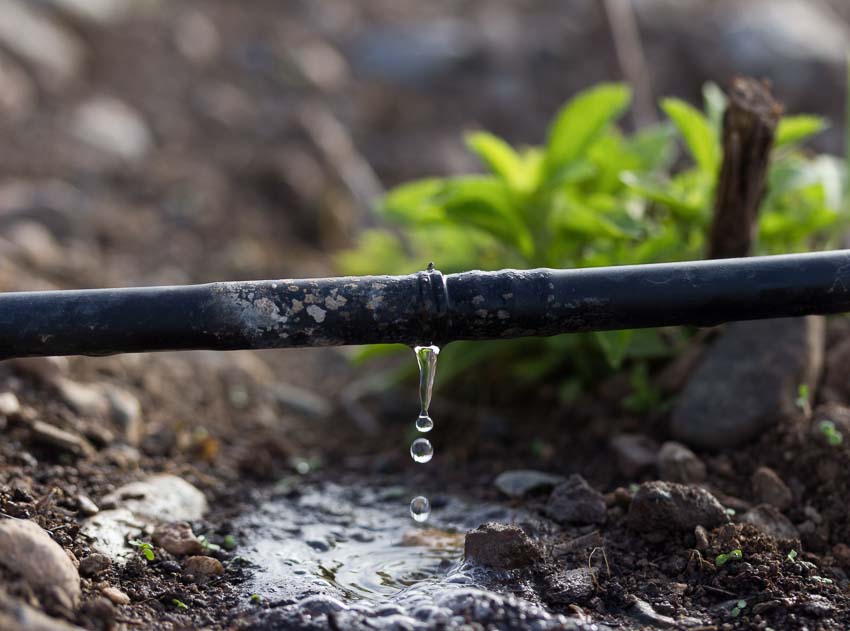Drip irrigation systems require some setup, but after the initial cost, they make gardening easier. Save money on your water bill and do less work while enjoying the benefits of improved plant health and growth. Learn more about the factors that affect drip irrigation costs and how to plan a drip irrigation system for your yard.
Factors Affecting Drip Irrigation System Cost
There are many different ways to set up a drip irrigation system, and several factors will determine how much you spend. Here are the key considerations that influence the cost of a drip irrigation system.
Size and Complexity of the Area to be Irrigated
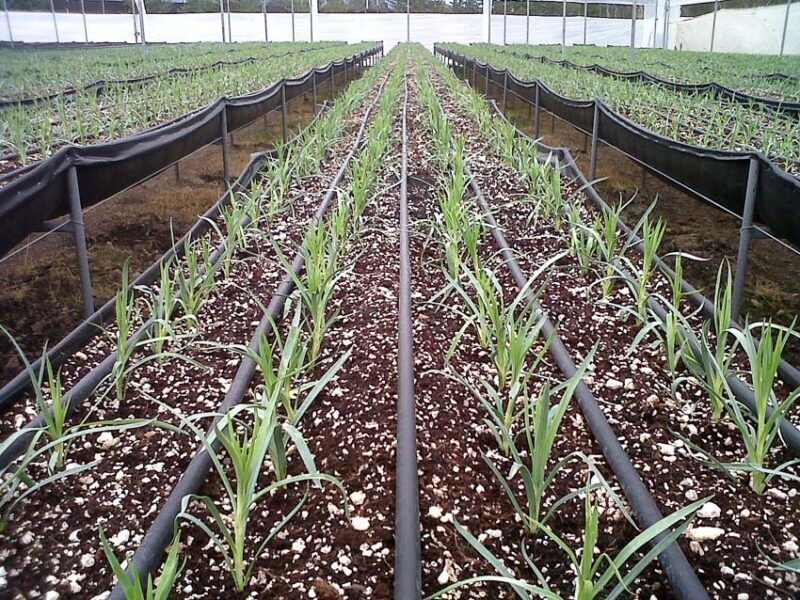
One of the main factors to consider is your garden’s size and the design’s complexity. A larger area means more materials and components, and complex designs often require multiple zones. They also take longer to install.
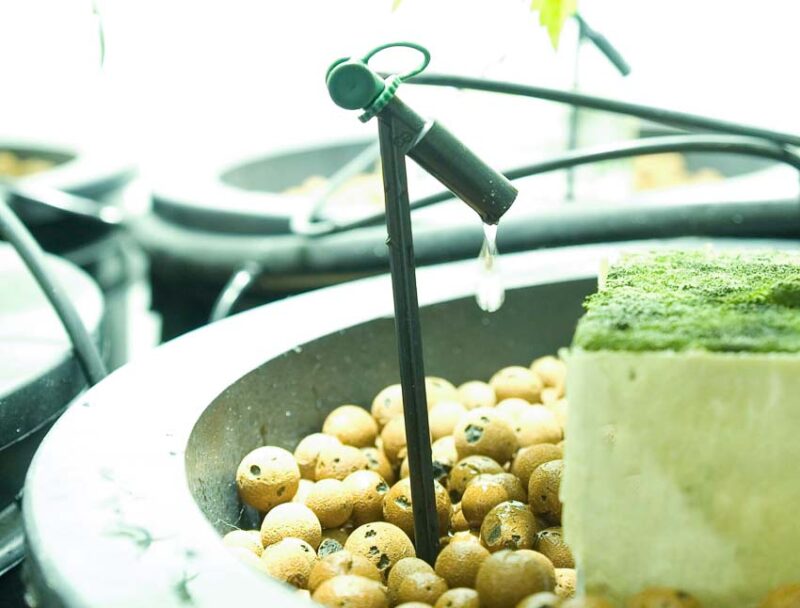
Water Source and Pressure Requirements
Private wells, groundwater, municipal water, water tanks, and rainwater collection systems are all possible water sources for drip irrigation. Drip irrigation systems need about 20 to 25 psi (pounds per square inch) to operate.
Each zone of your drip system should have a maximum of about 200 feet of ½” poly tubing, and if you have low water pressure, you may need more zones so that you’re not asking each zone to supply water to too many emitters.
The Water Needs of Your Grass and Plants
Some plants and grasses require more water. If you’re using native plants for a xeriscaped landscape design, your system will require less water. The more water your plants need, the more zones and emitters your system will require.
Quality and Types of Drip Irrigation Components
The two most common types of drip irrigation piping are PVC tubing and low-density polyethylene (poly) pipe.
- PVC is semi-rigid, and poly pipe is flexible.
- PVC is stronger, but poly pipe holds up to cold weather better.
- PVC is more expensive than poly tubing.
- Since poly tubing is flexible, it requires fewer fittings, lowering your overall cost.
Professional Installation vs. DIY Installation
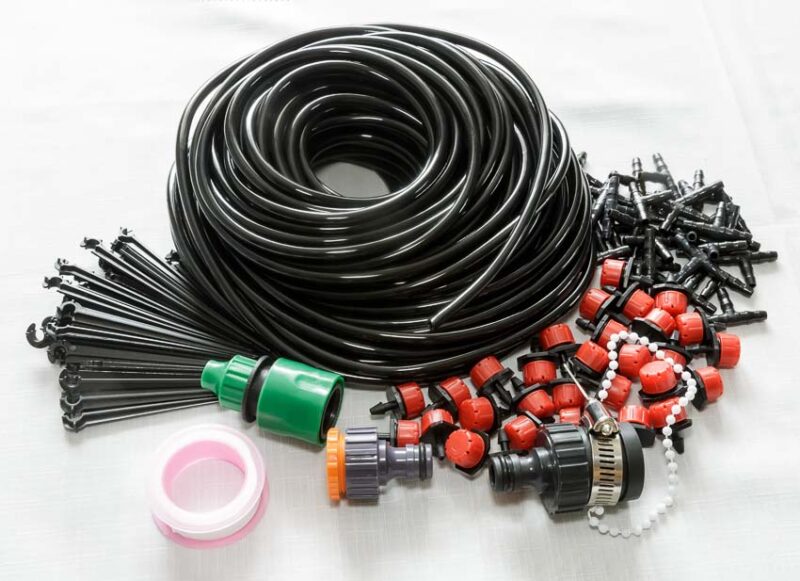
Installing your own drip system can save money, and even if you don’t have a lot of experience, you can purchase a DIY drip kit that takes all the guesswork out of installation. It takes less than a day to install a drip irrigation system for a small garden, and one of the benefits of doing it yourself is that you get to build it exactly how you want it.
Additional Accessories and Automation Features
You can set up a drip irrigation system without a timer, but you’re missing out on one of drip irrigation’s biggest benefits, automatically scheduled watering. There are many different timers, allowing you to program a schedule for all of your zones. You can also use soil moisture sensors to turn the system off and on.
Add rain sensors and integrate your system with a weather station that measures rainfall and responds to your garden’s needs. You can also add fertilizer injectors that allow you to automate fertilizing.
Breakdown of Drip Irrigation System Expenses
Small, simple drip systems can cost as little as $50, and larger, more advanced systems can cost up to $4,000. The drip irrigation cost per acre is $800 to $4,500 per acre.
Cost of Drip Irrigation Components
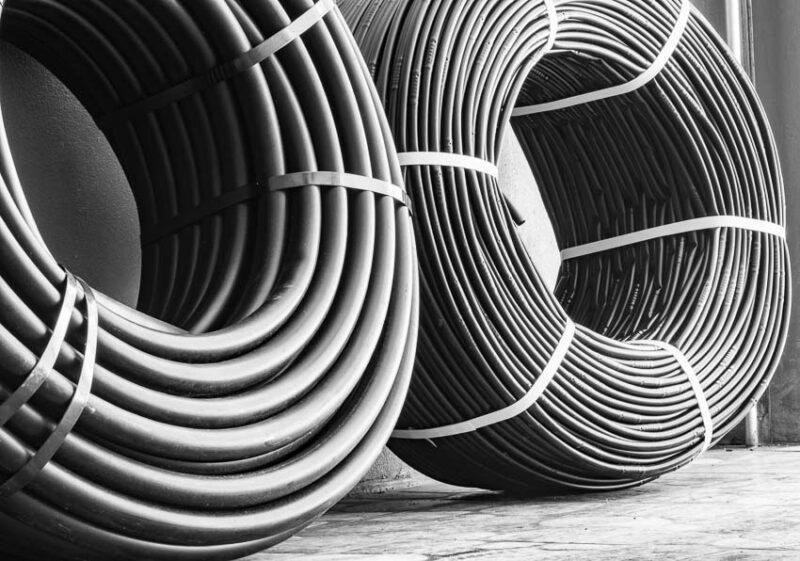
In addition to the tubing, you need several parts for your drip irrigation system. The size and design of your system will determine which components your system requires.
The overall cost of drip irrigation systems is lower when you purchase components in bulk. The fittings cost much more when you purchase them individually versus buying a 20-pack, and tubing is more expensive when you buy small rolls.
Drip Lines or Tubing

Most drip systems use poly or PVC tubing to run the main line and tee off with ¼” drip tubing for individual plants. You can also run soaker hoses or flexible drip lines with factory-installed pressure-compensating emitters spaced various distances apart. Choose from many different types of tubing in ¼”, ⅜,” ½,” and ¾” diameters.
| Tubing | Size | Price |
| Mainline poly tubing | ½” | $0.15 to $0.10 per |
| Mainline poly tubing | ¾” | $0.42 to $0.34 per foot |
| Mainline PVC pipe | ½” | $0.47 per foot |
| Mainline PVC pipe | ¾” | $0.50 per foot |
| Drip tubing | ¼” | $0.08 to $0.10 per foot |
| Porous drip soaker hose | ¼” | $0.24 per foot |
| Drip line with 6” emitter spacing | ¼” | $0.17 per foot |
| Drip line with 12” emitter spacing | ½” | $0.35 per foot |
Emitters, Drippers, or Sprinklers
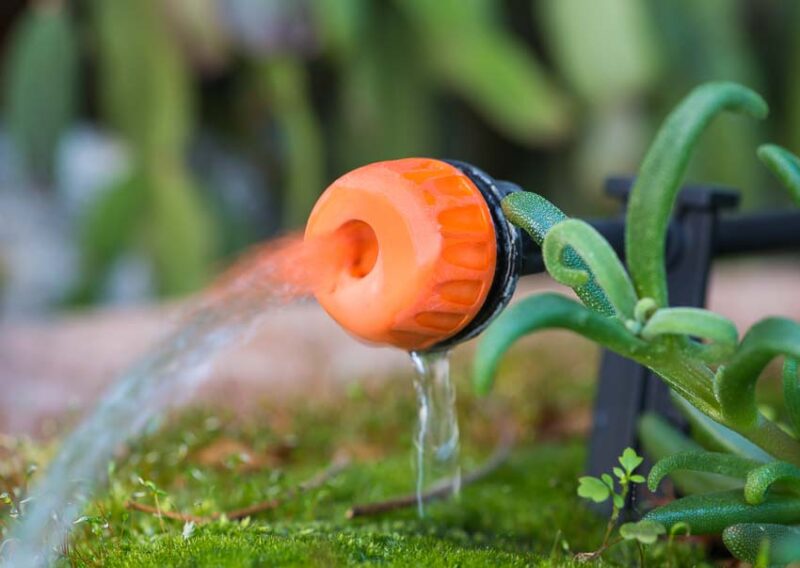
There are many different options when it comes to emitters and sprinklers to add to your drip system.
Emitters
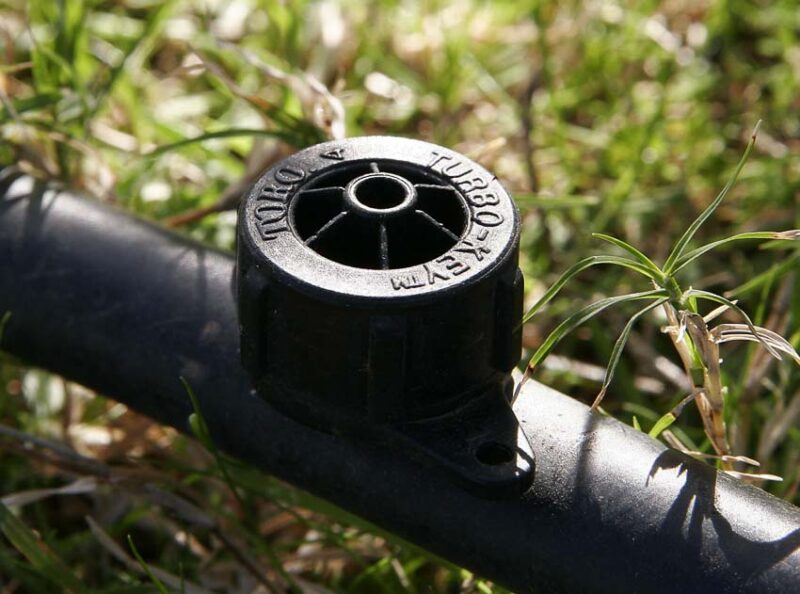
Here are the main things to know about emitters.
- Emitters are also called drippers.
- There are two types of emitters, including pressure-compensating and non-pressure-compensating. Compensating for pressure works best when running long distances, having low pressure, or having uneven terrain.
- Emitters are rated in gallons per hour (gph), typically ½, 1, 2, and 4 gph. They can also be adjustable. It helps to keep all your emitters rated at the same gph because it makes it easy to calculate the load on your system.
- You can install emitters directly in ½” mainline tubing or install them on tubing that’s connected to the mainline with ¼” connectors.
- Emitters cost $5 to $10 for a pack of 10.
- ¼” connectors cost about $8 for a pack of 50.
- You’ll also need goof plugs for mistakes, which cost about $3.00 for a 20-pack.
Sprayers
Drip system sprayers, or sprinklers, are a good choice for lawns and plants that need a lot of water. However, it’s important to remember that one of the best things about drip systems is they keep water off your plants and deliver it directly to the roots, where it’s needed and won’t evaporate.
Several types of sprayers include adjustable, directional, circular, and pressure-compensating sprayers. Some are installed directly into the mainline tubing, and some are connected with ¼” connectors.
- Sprayers cost $0.35 to $3 each, depending on the type.
Filters and Pressure Regulators
Poly drip tubing and the connectors are rated for about 25 psi, so if your system has more pressure than that, you need a pressure regulator. You also need a filter to keep your system from getting clogged with debris and dirt particles. Finally, a backflow preventer keeps water from flowing back into your system.
- Pressure regulators cost about $7 to $20
- Filters typically cost between $3 and $20
- Backflow preventers for drip systems cost $5 to $7
Valves
You can use as many valves as you want, but the more you use, the more it costs. Valves are helpful when you want to stop watering parts of your garden, but adding them at any time is easy.
- Valves cost about $2.50 to $5 each, depending on the brand, tubing size, and type of pipe.
Fittings
Drip system fittings like tees, elbows, and couplers are for assembling your piping. Male hose ends with caps are great for ending a line, but you can save money by folding over your line and using a zip tie because the pressure is low enough.
- Fittings cost about $1.50 or less each, depending on the type and whether you purchase them in bulk.
- Male hose ends cost about $1.50 to $3.00 each.
Installation and System Design Costs
Most professional landscapers can design and install a drip irrigation system—professional drip irrigation installation costs about $50 to $100 per hour. Simple systems can be installed in less than an hour, but you’ll pay more if your system is large or installed underground.
Costs of Additional Accessories and Automation
You can use add-ons for your drip watering system to automate watering and fertilization, which will add to the cost of your system. If necessary, start with an inexpensive one-zone battery timer for small gardens.
Another way to automate your system is with a soil moisture sensor, which costs about $20 to $300, depending on the size of your system and the sensor technology.
Evaluating the Cost-Effectiveness of Drip Irrigation Systems

How much money does drip irrigation save? Saving money on your water bill is the most significant benefit of a drip watering system. Learn more about the cost-effectiveness of drip irrigation systems.
Long-Term Water and Energy Savings
With drip systems, there is less overwatering, and since you’re applying water near the surface, it isn’t lost to evaporation. It depends on your system, but most experts estimate you use 30% to 80% less water with drip irrigation.
Learn about the pros and cons of earthworms in your soil!
Potential Savings on Maintenance and Plant Health
Irrigating with drip systems is efficient. It improves the health of your plants and increases crop yields. People typically get 10% to 50% more produce with drip irrigation, depending on the type of plant.
You’ll save time with a drip system because you’ll have fewer watering chores to do, and as an added benefit, you can leave town for the weekend and not have to worry about watering your garden.
Tips for Cost Optimization and Budgeting
Optimizing your cost savings requires proper system design, planning, and regular maintenance.
Proper System Design and Planning
It may take longer to plan and design your drip irrigation system than it does to install it. Proper planning will save you money because your system will cost less when you maximize each watering zone. In some cases, you can save money by using fewer drip emitters per plant and running your system longer.
Considering DIY Installation
About 60% to 75% of the cost of a drip watering system is labor and installation costs. Since the pipe and components of drip systems are relatively inexpensive, there isn’t a lot of risk involved with DIY installation, and it’s a great way to optimize the cost-effectiveness of your system.
Regular Maintenance and System Monitoring
Drip irrigation systems require some maintenance. The most important task is winterizing your drip irrigation system so it doesn’t freeze. Here are some other tasks you must do throughout the growing season:
- Monitor your system for leaks in pipes and emitters.
- Replace and repair piping and emitters as necessary.
- Clean the filter once monthly.
- Winterize your system by flushing it.
- Flush your system when you start it back up in the spring.
A drip irrigation system lasts about 12 to 15 years when properly maintained. Some parts will need to be replaced sooner, but you can enjoy years of efficient water delivery with regular maintenance and system monitoring.
Frequently Asked Questions About Drip Irrigation System Cost
How much does a drip irrigation system cost on average?
The average cost of a drip irrigation system is about $500, but people spend anywhere from $50 to $4,000, depending on the size of the system and whether they install it themselves or hire a professional.
Can I install a drip irrigation system myself to save on costs?
Most people save between $150 and $300 installing their own drip irrigation system for their garden. Most people have the skills required to install an underground irrigation system themselves.
Are there any ongoing maintenance costs for drip irrigation systems?
Maintaining a drip irrigation system is simple compared to underground irrigation systems. Monitor your system throughout the season to ensure the fittings stay connected, and clean out the filter every month. If you have a battery timer, you will need to replace the battery every few months. Blow the water out of the lines with an air compressor at the end of the growing season.
Will a drip irrigation system help reduce my water bill?
Compared to using a regular sprinkler, a drip water system uses about 30% to 80% less water, so you’ll save money on your water bill every month.
What factors should I consider when choosing between professional installation and DIY installation?
Professional installation costs more, but the experience and expertise of a professional may be worth it. Consider the size and complexity of your system because if you’re not sure what you’re doing, you can waste more money installing a larger system.

